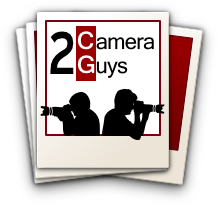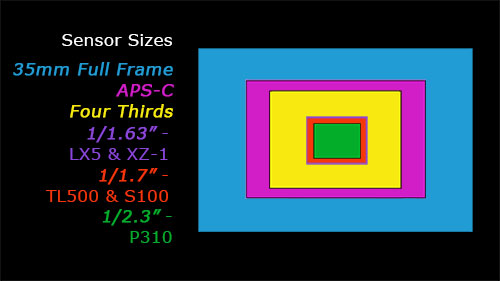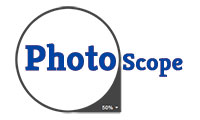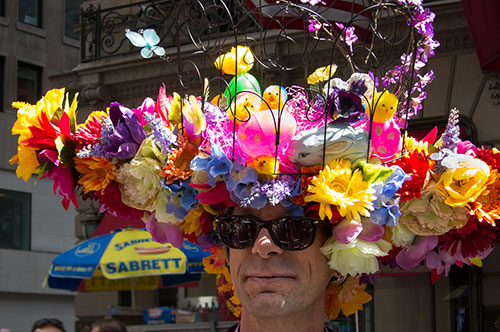Best Pocket Camera:
Shootout of FiveTop Models
The Pocket Camera Shootout
As a category, Pocket Cameras are not especially well defined. About the only concrete thing that you can say is that they should fit comfortably in your shirt pocket.
But there is a whole gaggle of Point and Shoot cameras that are also pocketable. What distinguishes a Pocket Camera? In the 2 Camera Guys taxonomy, Pocket Cameras are a step up from Point and Shooters, providing more features, better picture quality, and of course, a higher price tag.
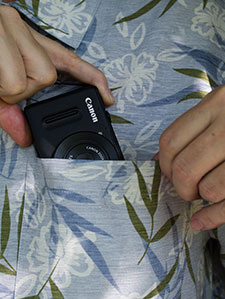
For example, most respectable Point and Shoots are under $250, while the least expensive camera in this Pocket shootout is about $325. For the extra cash, a Pocket Camera usually furnishes a superior lens system, which delivers upgraded image quality.
Speaking of lenses, we have split our Pocket Cameras into two shootouts, a Superzoom Pocket composed of competitors with long range zoom lenses, and this battle royal between Pockets with less extended zoom ranges, usually between about 24mm - 120mm.
For this April 2012 Shootout of Pocket Cameras, five of the top models that are currently available in the marketplace have been chosen: the Canon PowerShot S100, the Nikon COOLPIX P310, the Olympus XZ-1, the Panasonic LX5, and the Samsung TL500. (You can see a side-by-side comparison of the specs and features of these cameras here.)
All of these pocket cameras are capable of producing good quality photos. If you are not too demanding, one of them might be ideal for all of your photographic needs. For other folks, the portability of these mighty mites make them a great second camera that you can grab as you race out the door.
Each of the models includes one feature or another that makes it stand out from the rivals, which made picking a clear cut winner difficult. But in the end, one pocket camera rises above the rest.
The winner of our 2 Camera Guys Award for Best Pocket Camera goes to the Canon S100.
BEST POCKET CAMERA
Canon PowerShot S100
$405 with 5x Optical Zoom Lens, 12.1 MP - (More Specs)
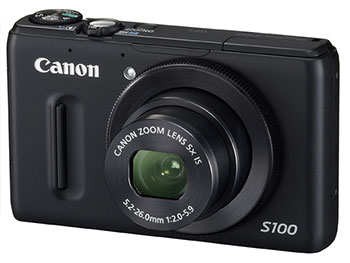
To begin, the Canon S100 is the smallest camera in this shootout, (the Nikon P310 is the lightest by decimal points). When you power down the S100, a two-piece plastic protector covers the 24mm - 120mm lens as it retracts into the slim body.
With its svelte dimensions and rugged build, this Canon is undeniably portable, even fitting comfortably in the back pocket of your Levi's - depending on the size of your derriere. Just remember not to sit down.
The image quality of the S100 is on par with the other cameras in this group, which means that it is good - not great - but just dandy for everyday snapshot and Facebook-like applications. (Read the Compromises section below.)
The S100's zoom range of 5x is the longest in this shootout, giving you a little more reach on the telephoto end, which is helpful when shooting sporting events.
Though not the clear champ in every phase of the shootout, the Canon S100 ticked most of the boxes and earns the Best Pocket Camera award.
More about the Canon PowerShot S100.
Olympus XZ-1
$495 with 4x Optical Zoom Lens, 10 MP - (More Specs)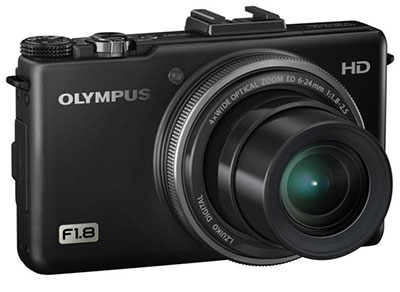
The Olympus XZ-1 is the most expensive model in this shootout, which usually drops it down the list.
But in a Fifth Avenue Easter Parade real world test, it yielded the consistently best, sharpest and most pleasingly colorful images, which pushes it right back up the list and in serious contention for the top spot.
Even though the XZ-1 lens does retract, the camera weighs almost 40% more than the Canon S100 and it will strain a shirt pocket.
In addition, the XZ-1 only shoots 720p video, which is fine for YouTube, but not as high of resolution as Canon's 1080p, which looks better on a big screen HDTV.
Then again, if your main deciding factor is still image picture quality, give the XZ-1 a long look. And while you are considering spending around $500, you might want to compare it to the similarly priced Sony Alpha NEX-C3 mirrorless camera.
Nikon COOLPIX P310
$330 with 4.2x Optical Zoom Lens, 16 MP - (More Specs)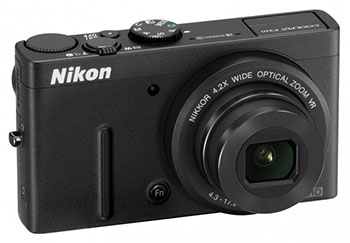
Just looking at the specs for the newly released Nikon P310, you may wonder why it's not the king of the hill.
It's the lightest and only a whisker larger than the Canon S100, making it truly pocket-friendly.
Also, Nikon has packed the most megapixels on the P310's sensor, a third more than its closest contestant.
But that sensor is also the smallest of the bunch and though the image quality on the P310 is good, it doesn't stand out against the Olympus XZ-1.
With that said, the Nikon is also over $150 less than the Olympus, which places the P310 at the tippy-top of the Bargain Pocket Camera list.
Panasonic DMC LX5
$385 with 3.8x Optical Zoom Lens, 10 MP - (More Specs)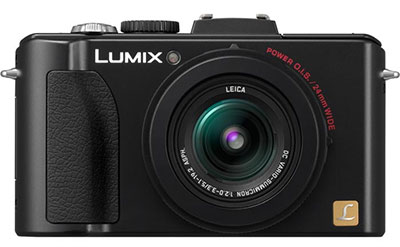
Considering the normal product cycle of pocket cameras, the Panasonic LX5, (which first shipped in August 2010), is becoming a little long in the tooth.
But sporting a high quality Leica lens, this Lumix LX5 shares a deluxe pedigree as a virtual clone of the twice as expensive Leica D-Lux 5.
Putting the talk about designer labels aside, the image quality of the LX5's RAW files is quite good.
As for compactness, the 24mm-90mm lens does not retract and the sturdily built body is one of the heaviest in the group, not exactly a pocket pal.
If you desire the Panasonic/Leica cachet and are the patient type, you could grab a deal as the price of the LX5 drops as it nears the end of its life cycle. Or simply wait for the new and improved LX6 (though no date has hit the rumor mill yet).
More about the Panasonic LX5 .
Samsung TL500
$399 with 3x Optical Zoom Lens, 10 MP - (More Specs)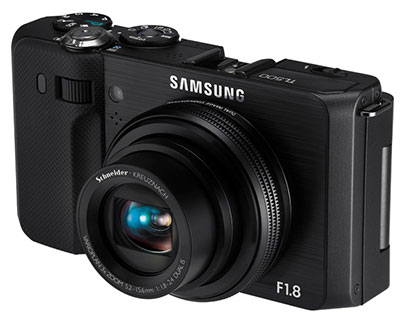
The Samsung TL500 (also called the EX-1 in some markets) is officially out of production, though at the time of this review, you can still purchase new stock online.
Being the biggest and heaviest model, the TL500 barely fits into this shootout category and only manages to slip into a cargo pants pocket.
But straight out of the camera, the RAW images are sharp and saturated. And if the picture quality doesn't make you forgive the extra few ounces of bulk, then the articulating screen will.
Not only does the rotating screen allow you to shoot at difficult angles, the bright and clear OLED screen is the best of the group, which is a welcome boon when shooting in glaring sunlight.
Samsung has not announced a replacement for the TL500.
Pocket Camera Compromises
Purchasing a camera always entails a series of compromises and tradeoffs.
Even though the price of a pocket camera isn't exactly pocket change, manufacturers try to control costs by using less expensive components or trimming certain features.
Most critically, all of these pocket cameras contain a relatively small image sensor, which is the heart of a digital camera. As a general rule, the bigger the sensor, the better.
The biggest image sensors of the five models in this shootout belong to the Panasonic LX5 and the Olympus XZ-1, (1/1.63") and the 1/1.7" sensors on the Samsung TL500 and Canon S100 are only slightly smaller. Still, as you can see from the diagram below, all those sensors are almost five times smaller than the one in a Micro 4/3 mirrorless camera.
Not only does picture quality suffer with a smaller sensor, but the cameras also don't perform as well in low light situations.
This is a tradeoff that many enthusiasts may not be willing to make for the pocket-ability of these cameras.
Sensor technology is constantly improving, but simply don't expect big sensor picture quality with these tiny sensor cameras and you won't be disappointed. (Admittedly, shooting outdoors in bright light often yields wonderfully colorful photos.)
In addition, none of these models provides a dedicated viewfinder. If you are stepping up from a smartphone or a point and shoot camera, that might not be a problem. If you depend on a viewfinder, expect to adjust your shooting style or shop elsewhere.
And the touchscreen phenomenon has yet not migrated to pocket cameras. On all of these cameras, you navigate through the menus with buttons and wheels.
Finally, the battery life on all these cameras is not that long, usually about 200 shots. This might seem like a minor issue until you are shooting your daughter's birthday party and the battery dies. If you buy one of these cameras, purchase at least one extra battery. You'll thank yourself later.
You can read more detailed individual reviews of these cameras on the following pages.
Best Pocket Camera
Canon PowerShot S100
Canon PowerShot S100
The predecessor of the Canon PowerShot S100, the Canon S95 was a favorite not only for its size but also the quality of the images that it produced.
With the S100, Canon has upped the megapixel count from 10 to 12 and implemented a new image processor that reduces noise.
Basically, the S100 is an improved version of the S95 and it is already winning over devotees.
And deservedly, the Canon S100 has won the 2 Camera Guys Award for Best Pocket Camera (non-Superzoom).
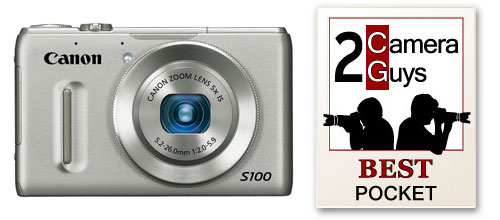
The Good, the Bad and the So-so
Lifting the S100 out of its box, my first impression was ding-dang this puppy is tiny. Take your smartphone out of your pocket, double it in depth, add a couple of ounces and you have the S100.
Its size and solid construction make the S100 an ideal, take-anywhere, travel companion. True to its designation, you can slip it into your pocket or handbag or simply slip your hand through the wrist strap and have it at your fingertips.
Weighing about seven ounces, you can carry it around for extended periods of time without your hand cramping up.
Of course, portability doesn't mean anything if the image quality is not up to snuff. In well-lit conditions, the Canon S100 performs admirably. But even with the new DIGIC 5 image processor, noise becomes problematic with ISO settings over 1600.
Though judge for yourself with this PhotoScope comparison of the Canon S100 at different ISO's. If you click the link, the image on the left has the ISO at 200, the one on the right is ISO 3200. If you roll the Scope over the blue and purple label on the olive jar, you can clearly see the noise in the right image. Cycle through some of the other ISO settings to judge how the S100 fares.
One of the disadvantages of a tiny camera is that it can be awkward to hold, especially if you have big hands. To assist your grip, the Canon designers have added a two-finger indentation on the front and a very slight -and slightly slippery - thumb indentation on the back, neither are that effective.
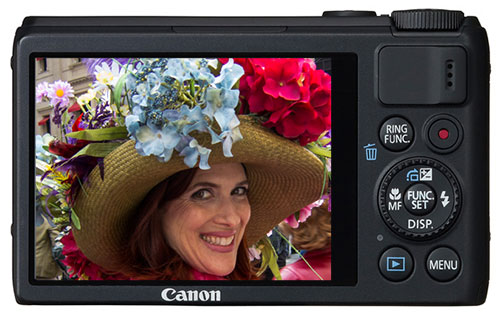
As for the rest of the layout, I like the traditional mode wheel at the top of the S100. But please explain to me why Canon had to label the Shutter Speed mode Tv (Time value) instead of S and Aperture mode Av instead of just A. It's unnecessarily confusing.
Pocket cameras should be easy to use and the operation of the S100 is fairly straightforward.
If you don't want to fiddle with controls, you can set the mode to Automatic and the little elves inside the camera will do all the work for you.
Though the one aspect that I don't like about Auto is that the flash will pop up if the camera senses that there is not enough available light. If there is one function that I want to control, it's if and when the flash goes off.
With the S100, Canon has added a GPS feature, which can be a must-have to the inveterate hiker/photographer who likes to keep track of where photos are captured.
Though attaching GPS data onto your image files also raises security and privacy issues, especially when you include that info on photos that you upload to websites like Flickr.
Fifth Avenue Easter Parade
Also, the battery life on this Canon is anemic and the GPS can drain it even faster. Buy an extra battery - even better, make it two - and keep them charged.
Finally, the Canon S100 supplies many other features including 1080p video recording, and a long list of effects and scene modes like HDR (High Dynamic Range). And for a little late night light reading, there's a 235 page Users Guide.
Conclusion
With the PowerShot S100, Canon has improved upon their popular S95 with better still image quality and higher resolution video recording, while retaining a truly pocketable form factor.
This combination of features earns the S100 our 2 Camera Guys Best Pocket Camera Award.
Canon PowerShot S100 Photo Gallery
More about the Canon PowerShot S100
Canon PowerShot S100 spec sheet
Compare the Canon S100 to the Competition
Olympus XZ-1

If this Pocket Camera shootout was judged on the contestant's quality of still images, then the Olympus XZ-1 would ascend to #1, especially when taking photos in well-lit conditions.
When shooting the Easter Parade on Fifth Avenue, the images taken with the XZ-1 set my eyelids aflutter because they were so consistently rich and silky.
Alas, there were other factors involved in this shootout and the relatively stocky XZ-1 didn't fare as well on the pocket-ability scale and is the most expensive camera of the group.
The Good, the Bad and the So-so
The Olympus XZ-1 doesn't perform well in low light conditions, particularly when you have to set the ISO over 800. The images begin to exhibit too much distracting noise.
If you are shooting JPEGs, the in-camera image processor tends to apply too much noise reduction, which softens the images. If you opt to capture RAW images, the in-camera noise reduction is turned off and you can dial up your own level of reduction in a program like Photoshop.
Remember, this noise is a problem at high ISO numbers. I would suggest setting the XZ-1 to capture both RAW and JPEG formats. (You can read about that option in the manual.) As a test, shoot under a variety of conditions and compare the two choices. Then to save storage space and battery life, pick the one that best suits your needs.
On the plus side, the lens on the XZ-1 is one of the fastest in the shootout, with 1.8 being the widest aperture. The wider the aperture, the more light comes through the lens allowing you to keep your ISO setting low.
Other features that you may find useful include Macro and Super Macro settings for those close-ups and extreme close-ups of flora and fauna. (Again, read the manual to locate how to choose these functions.)
The multiple Art Filters and the Scene modes found in many new digital cameras often seem gimmicky and the XZ-1 has its share of them. Though you might feel an Art Filter like Grainy Film or Dramatic Tone strikes your fancy. Or a Scene selection like Cuisine might be a perfect quick setting for capturing that assortment of peppers at the Farmers Market.
A couple of other points, the Olympus designers do not provide a grip on the front of the camera and only a slight grooved surface on the back for your thumb, which doesn't give you the most secure feeling when holding the XZ-1. For a little tighter rein, you could wrap the strap around your right thumb.
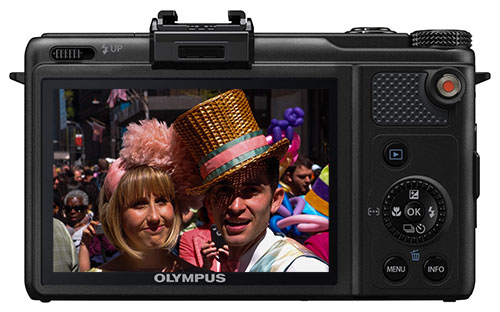
The three inch display on the back is fine if you aren't shooting in bright sunlight and then it becomes almost useless. Olympus does offer the VF-2, an electronic viewfinder that attaches to the XZ-1's hotshoe. It's a great accessory. Only problem, at $249, it costs half as much as the camera itself.
Also, unless you are a savant, be prepared to consult the manual. The basic operation of the XZ-1 is fairly simple. But with a camera with this many options, the location of some of the functions, (like where you choose between the RAW or JPEG format) are not instantly apparent.
Finally, the XZ-1 records HD video in 720p resolution and not 1080. If you are only posting videos on the Internet, 720 is perfectly fine. If you have dreams of being a low budget David Fincher, then opt for a camera that shoots at 1080p.
Conclusion
Of the five cameras in this Pocket shootout, buy this Olympus XZ-1 if your primary concern is the quality of still images (not video) and you are willing to tradeoff true pocket-ability for PQ (picture quality).
The XZ-1 is the most expensive camera in the group, but as its product cycle nears its demise, you might be able to grab one at an irresistible price.
Olympus XZ-1 Photo Gallery
More about the Olympus XZ-1
Compare the Olympus XZ-1 to the Competition
Nikon COOLPIX P310
The Nikon COOLPIX P310 is the newest release in the shootout and obviously the Nikon designers and marketers studied the competition to find a profitable pocket for this tiny camera.
The diminutive P310 replaces the similarly sized Nikon P300 and the most notable change is an increase in megapixels from 12 to 16, the most of any of the cameras in the contest.
But the P310 also features the smallest image sensor size, which ultimately affects picture quality (PQ), and not in a good way. That is not to say that photos from the P310 are bad. They just can't consistently match the PQ from their rivals.
The two areas that the P310 does compete quite well is size and price, being the lightest and least expensive. And when you are comparing pocket cameras, those attributes count, a lot.
The Good, the Bad and the So-so
First, let's deal with the So-so, the P310's PQ. For common tasks like sharing party photos and uploading images on to your Facebook page, the output from this COOLPIX is, well, cool enough.
For more critical applications like printing 8x10's or larger, the differences between the P310 and the Olympus XZ-1 may - and I emphasize may - become more apparent.
Another criticism from those who like to achieve the last drop of quality from a photo is that Nikon does not offer a RAW image capture option with this camera.
I'm a Team RAW supporter and the P310 should capture in RAW. But you can open JPEGs in Photoshop's Camera Raw utility and take advantage of those editing tools.
What may be more important to many is the basic handling and ease of use of the P310.
The weight of the camera is not a problem unless it seems too light in your hands. And the build feels substantial.
Like the Canon S100, big hands dwarf the P310 and the minimal two finger ridge in the front and teensy thumb grip on the back don't give you much to clamp on to.
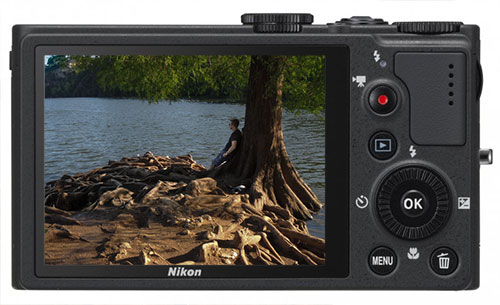
The resolution of the three inch screen is the highest in the shootout and the detail when viewing photographs or paging through menus is appreciated.
With the mode wheel at the top, it's easy to switch quickly between the typical PSAM (Program, Shutter, Aperture, Manual) exposure modes. Or you can let the camera take over and set the dial to Auto.
The on-screen menu is not overly populated with frivolous features which makes navigation less dizzying.
Since there is no dedicated button for setting ISO, I prize the ability to program the Function button located on the front of the camera.
I'm not a big fan of all the Scene modes, though I was curious about Museum mode. If for no other reason, researching and experimenting with the different Scenes will make you more familiar with your camera.
I'll admit that I'm a sucker for the Panorama feature and the P310 has the best one in the shootout. There's not even a close second. You simply press the button and rotate, and the camera performs all the stitching in front of your expectant eyes.
You even have two Panorama options, taking a 180 degree image or a full monty 360 degree photo.
180 degree panorama shot
If you own a 3D HDTV, the P310 includes an ingenious 3D utility in which you take one photo and then move the camera horizontally until you align the view with an overlaid guide and the second image is captured. Then the camera constructs a 3D MPO file that you can playback on your TV and view with 3D glasses.
Finally, this COOLPIX shoots 1080p video as well as lower resolution clips at a higher frame rate, which then playback in slow motion.
Conclusion
If you are looking for a truly pocketable camera at a bargain price, then the Nikon COOLPIX P310 fills the bill.
Compared to the other cameras in this shootout, you will be trading a little bit of picture quality for the lower price tag. But the P310 has a few tricks up its lens, like a smooth Panorama mode and a clever 3D feature, that you will not find in the other contestants.
Nikon COOLPIX P310 Photo Gallery
More about the Nikon COOLPIX P310
Compare the Nikon COOLPIX P310 to the Competition
Panasonic Lumix LX5
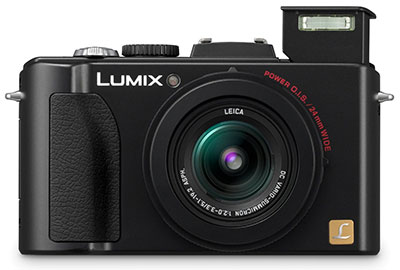
For a number of very good reasons, the Panasonic LX5 does not deserve to be this far down the list.
With its second birthday fast approaching, its fair to call this Lumix an old workhorse, solid and dependable.
Newer models in this shootout may seem flashier, but the combination of the biggest image sensor (along with the Olympus XZ-1) and a top notch Leica lens produces very good quality images.
Therefore, the LX5 still demands serious consideration.
The Good, the Bad and the So-so
I confess. I have a history with Lumix cameras. I bought the LX3 when it first was released. It was a second camera to much larger DSLRs. The Lumix was the one that you carry around with you everyday.
It was reliable, always within reach to catch a shot before the opportunity passed by. The images were very good, not usually up to the DSLR standard, but never expected to be.
One day, the camera just disappeared. Gone but not forgotten. Excuse me, I'm misting up.
From my brief time with the LX5, I feel the same about it, comfortable and trustworthy.
The LX5 is one of the larger cameras in this group, which allows the grip on the front to be big enough to accommodate three fingers, making it feel more secure in my hand.
The layout of the mode wheel and most of the other buttons are very similar to the other models in this shootout. And like them, most of the functions are accessed from an on-screen menu. Some settings, like ISO, have dedicated buttons on the back.
The three inch screen has the lowest resolution of the five models, though the Canon S100 is only slightly higher. Panasonic does sell the LVF1, External Live View Finder, ($179), which attaches to the hot shoe and makes using the camera in bright sunlight a pleasure rather than a pain.
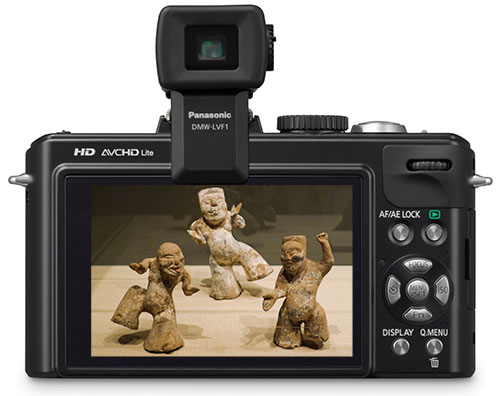
The Panasonic LX5 with the optional LVF1 attached.
The LX5 does show its age when it comes to video recording. Its max resolution is 720p and it captures in either the cumbersome Motion JPEG format or the more efficient AVCHD Lite. If you are serious about shooting video, pass the LX5 by.
Conclusion
It's about time for Panasonic to put the LX5 out to pasture, though that Leica lens is timeless.
If you are looking for a trusty, sturdy travel companion, the LX5 could serve you well for years to come.
Panasonic Lumix LX5 Photo Gallery
More about the Panasonic Lumix LX5
Panasonic Lumix LX5 spec sheet
Compare the Panasonic Lumix LX5 to the Competition
Samsung TL500
Since the Samsung TL500 is now out of production and a new (not refurbished) model is becoming hard to find, the comments made in the Introduction suffice.
The only thing that I can add is that if you are a bargain hunter looking for a large pocketable camera - with a great articulating screen - that produces quality images (see the photo gallery below), then keep your eyes peeled for the Samsung TL500 (also called the EX-1 in some markets).
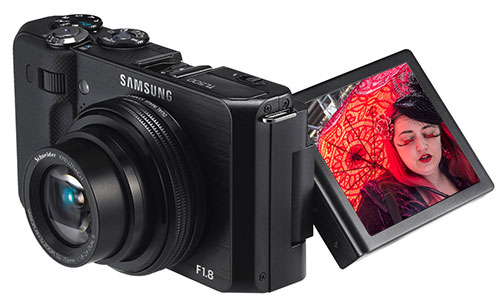
The Samsung TL500 with an articulating screen.








